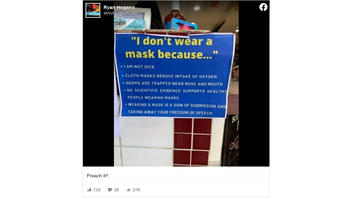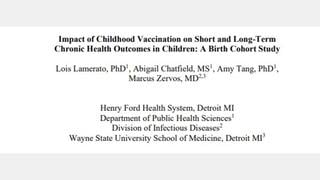
Did a meme provide five accurate reasons why people should not wear masks amid the novel coronavirus outbreak? No, several of the reasons were misleading. A viral post about why "I don't wear a mask" gives five reasons not to don a face covering to fight COVID-19, but several of them have been debunked by Lead Stories and other organizations like the CDC and scientific studies.
The claim appeared as meme in a post shared on June 5, 2020 on Facebook (archived here) with the title "Preach it!!" It read:
I don't wear a mask because
I am not sick
Cloth masks reduce intake of oxygen
Germs are trapped near nose and mouth
No scientific evidence supports healthy people wearing masks
Wearing a mask is a sign of submission and taking away your freedom of speech
This is what the post looked like on Facebook at the time of writing:
(Source: Facebook screenshot taken on Tue Jun 23 17:29:21 2020 UTC)
Let's break down the reasons cited for not wearing a mask:
I am not sick
The reason medical experts have recommended that all people wear masks is to prevent the spread of the virus even if the person wearing the mask does not know they are infected. Being asymptomatic means someone is not showing symptoms or is "not sick," but they still may have COVID-19.
From the Centers for Disease Control and Prevention's recommendations to prevent infection:
A cloth face covering may not protect the wearer, but it may keep the wearer from spreading the virus to others.
COVID-19 spreads mainly from person to person through respiratory droplets produced when an infected person coughs, sneezes, or talks. These droplets can land in the mouths or noses of people who are nearby or possibly be inhaled into the lungs. Studies and evidence on infection control report that these droplets usually travel around 6 feet (about two arms lengths).
Wear Cloth Face Coverings
Wear cloth face coverings in public settings where other social distancing measures are difficult to maintain, such as grocery stores, pharmacies, and gas stations.
Cloth face coverings may slow the spread of the virus and help people who may have the virus and do not know it from transmitting it to others.
Cloth face coverings can be made from household items.
The CDC also explains how a mask can prevent spread by those without symptoms:
While people who are sick or know that they have COVID-19 should isolate at home, COVID-19 can be spread by people who do not have symptoms and do not know that they are infected. That's why it's important for everyone to practice social distancing (staying at least 6 feet away from other people) and wear cloth face coverings in public settings. Cloth face coverings provide an extra layer to help prevent the respiratory droplets from traveling in the air and onto other people.
New guidelines have been issued by the World Health Organization regarding wearing cloth masks.
According to Stanford University:
The new guidelines recommend that everyone who comes in close contact with others in crowded or close quarters, such as on a bus or in a store, wear a cloth mask composed of at least three different layers of material. People 60 or older, or those with underlying health conditions, should wear medical masks, such as surgical masks, in public, and physicians and health care providers should wear medical masks in all areas of a hospital, even if the area in which they are working has no COVID-19 patients, according to the organization.
Amy Price, a senior research scientist at Stanford's Anesthesia Informatics and Media Laboratory: and Larry Chu, a professor of anesthesia and director of the AIM Laboratory, spoke with science writer Krista Conger for Stanford about the new guidelines:
How do cloth face coverings prevent the spread of COVID-19?
Chu: In order to answer this, it's first important to understand the concept of source control. We've learned that as many as 40% of people infected with the virus that causes COVID-19 may have no symptoms. But when they talk, cough or sneeze, they can still spread the virus to others in the form of respiratory droplets expelled into the air. Those droplets evaporate into fine particles that may linger. The mask traps these larger droplets before they can evaporate. So, wearing a mask regularly can prevent spreading at the source even when we don't know we are sick. But masks are just one important way to prevent this disease from spreading. Washing your hands regularly and thoroughly and keeping at least 6 feet apart from one another are still vitally important.
Price: Many people argue that cloth masks can't be effective because they can't filter out viral particles, which are extremely tiny. But, as Larry explained, most of these particles leave the mouth and nose in much larger droplets that become smaller through evaporation as they move away from the body. Trapping droplets with the mask means not nearly as many viral particles escape. So, when all parties in a gathering are wearing well-constructed, well-fitting masks, it provides an extra layer of safety for everyone. If two people are wearing masks, the viral particles can travel about 5 feet away from each individual. When an infected person is not wearing a mask, those particles can float through the air 30 feet or more and stay alive for up to 30 hours.
The meme cited another reason not to wear a mask:
Germs are trapped near nose and mouth"
Price and Chu from Stanford addressed people not wanting to wear masks because the "concentration of viral particles around an infected person's mouth and could increase the severity of the illness."
How do you respond to people who feel that wearing a mask can be harmful?
Price: I've heard so many misconceptions about cloth masks. Some people think that if you wear a mask for long periods of time you will trap and breathe in excess amounts of carbon dioxide, which could lead to brain damage. That's just not true. A properly constructed mask provides more than enough ventilation. In fact, one way to test if your mask is well made is to try to blow out a candle through the mask from about 1 foot away. If you can't do so, your mask might be too tightly woven. Other people feel that wearing a mask encourages people to touch their face and to loosen their adherence to other safety precautions like social distancing and hand washing. We've found the opposite.
Wearing a mask reminds people to continue to be cautious. With a mask on, you actually touch your face less. People who experience skin irritation should ensure their mask has a layer of wicking fabric, like cotton, against the face, and everyone should change the mask if it becomes wet or dirty. Finally, it's been suggested that mask-wearing may increase the concentration of viral particles around an infected person's mouth and could increase the severity of the illness. While it's true that some studies of health care workers have suggested that the viral dose is an important determinant of infection, it's different for someone who is already infected. If you are sick, you already have the virus in your lungs; it's not going to get any worse.
Here is a video from Stanford titled "The best non-medical mask materials":
Another of the meme's reasons:
Cloth masks reduce the intake of oxygen"
This is not true.
Lead Stories debunked this claim with an article found here, which countered a claim that wearing a mask causes hypercapnia -- a buildup of carbon dioxide in the bloodstream.
According to HealthFeedback.org consistent use of a mask does not cause hypercapnia.
While it is true that hypercapnia can be life-threatening, the claim that it can be caused by wearing face masks, either surgical masks or respirators, is unsupported and runs contrary to existing evidence. The masks act as a barrier to keep out aerosols, but the materials used are still porous enough to allow gas molecules like carbon dioxide and oxygen to pass through, which are many times smaller than viruses. The size of a carbon dioxide molecule is estimated at about 230 picometers. In contrast, SARS-CoV-2, the causative agent for COVID-19, is about 60 to 140 nanometers[1], which is at least 10,000 times larger."
HealthFeedback.org gives an expert opinion on the warning about masks causing hypercapnia. Sofia Morra, a cardiologist at the Erasme University Hospital in Brussels, explained:
Wearing a surgical mask for short periods of time does not impact significantly physiological respiratory variables, and thus, whenever a rise in CO2 occurs in the 'dead space' of the mask, it is unlikely that the magnitude of this increase would be sufficient to impair immune, neurological, or cardiovascular homeostasis.
And another reason cited by the meme:
No scientific evidence supports healthy people wearing masks"
A study was published on June 12, 2020, by a team at Texas A&M University that found "not wearing a face mask dramatically increases a person's chances of being infected by the COVID-19 virus."
Science Daily reported on the study:
A study by a team of researchers led by a Texas A&M University professor has found that not wearing a face mask dramatically increases a person's chances of being infected by the COVID-19 virus.
Renyi Zhang, Texas A&M Distinguished Professor of Atmospheric Sciences and the Harold J. Haynes Chair in the College of Geosciences, and colleagues from the University of Texas, the University of California-San Diego and the California Institute of Technology have had their work published in the current issue of PNAS (Proceedings of the National Academy of Sciences).
The team examined the chances of COVID-19 infection and how the virus is easily passed from person to person. From trends and mitigation procedures in China, Italy and New York City, the researchers found that using a face mask reduced the number of infections by more than 78,000 in Italy from April 6-May 9 and by over 66,000 in New York City from April 17-May 9."Our results clearly show that airborne transmission via respiratory aerosols represents the dominant route for the spread of COVID-19," Zhang said. "By analyzing the pandemic trends without face-covering using the statistical method and by projecting the trend, we calculated that over 66,000 infections were prevented by using a face mask in little over a month in New York City. We conclude that wearing a face mask in public corresponds to the most effective means to prevent inter-human transmission.
"Our work suggests that the failure in containing the propagation of COVID-19 pandemic worldwide is largely attributed to the unrecognized importance of airborne virus transmission," he said. "Social-distancing and washing our hands must continue, but that's not sufficient enough protection. Wearing a face mask as well as practicing good hand hygiene and social distancing will greatly reduce the chances of anyone contracting the COVID-19 virus." Zheng said.
The final reason cited goes beyond medical research and science:
Wearing a mask is a sign of submission and taking away your freedom of speech"
The First Amendment argument has been used for people who do not want to wear masks, claiming it is a violation of the free speech guaranteed by the United States Constitution. However, a majority of states across the country have requirements for face masks in public spaces, although the individual cities and counties may have different mandates.
Thirty-seven states require a face mask as of June 23, 2020, according to Littler.com. Ten recommend wearing a mask and three do not have any requirements. Check out the breakdown by states here.
Read earlier Lead Stories articles about false claims concerning face masks and COVID-19:
Fact Check: OSHA Did NOT Say Cloth Masks Don't Work And Will Reduce Oxygen To Danger Levels
Fact Check: Card Does NOT Exempt Anyone From Wearing A Mask In Public
Fact Check: The CDC DOES Recommend That People Who Are Healthy Wear Facemasks
















